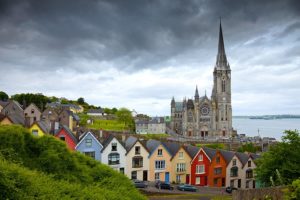
By Richard Ammon
GlobalGayz.com
Edited June 2017
Two Young Men’s Journeys through War and Bigotry: Seamus and Paul
Seamus
“At fourteen I was told by my (Catholic) school teacher that homosexuality was a satanic evil that dwells within—but if such a person was not consciously aware of his condition he was, instead, mentally ill.” This curse, Seamus told me, haunted him for years as he squirmed to come out as a gay young man in Derry, Northern Ireland. “I still feel angry that any young person should be damaged like that, but it shows you how strong the religion was here and how cruel it was.”
Seamus, is a handsome man of 22 with short dark hair, intense blue eyes, a boyish round face and ‘daVinci lips’. He speaks with a subdued intensity about his young life that was battered not only by the shells of harsh religious dogma but by the live ammunition of warring enemies as Irish Catholic ‘freedom’ fighters (wanting union with the Republic of Ireland) aimed bullets and bombs at British Protestant forces insisting that Northern Ireland remain a province of the UK under London’s rule. “I thought this was how life was. I grew up with it and didn’t know anything else.”
Once, desperately seeking a safe healing place for his gay soul, he confessed his anguish to a priest. The reply provided no relief: “We all have our cross to bear. Confession will bring you forgiveness for your sexuality but if you continue to be active you will live in sin.”
Breaking a deeply embedded belief, he no longer goes to church as he has matured and seen the church’s hypocrisy in forgiving the sexual behavior of repentant priests while condemning gays and lesbians. “The church is the most sexually confused place I can image,” he now says with a sardonic laugh.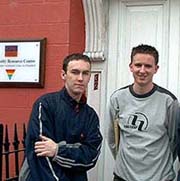 (photo right: Paul and Seamus)
(photo right: Paul and Seamus)
Seamus and his partner Paul became lovers in Derry in 2000. I met them when I arrived at Foyle Friend, the LGBT center in Derry (now closed). Seamus was 20 and Paul 23. The quality of their freedom, independence, legal status and social acceptance which they feel each sunrise day appears unremarkable and indifferently casual. But in fact their now peaceful and harmonious life as a modern gay couple seems nothing short of a marvel as I listened to the difficult struggle each had endured to come to their present togetherness.
Seamus grew up in Derry (Londonderry), the very site of the 1974 Bloody Sunday massacre of 14 Catholic protesters by British soldiers. His entire early life was punctuated by war. His father was incarcerated for no particular reason and held without trial by the British. He was taught to hate the Protestants (loyal to England) and his school was surrounded with razor wire and window cages.
At fourteen he knew he was gay; at 17 he was experimenting with the scary joy of gay sex. “But the last thing I could think about was coming out. There was so much other trouble.” At 19 he was a student for a year in America and felt safe enough to come out to himself. His emotional war with himself came to an end about the same time as the political war in Northern Ireland subsided. (The shaky but tenable Good Friday agreement of 1998 is seen as the beginning of the end of the ‘Troubles’)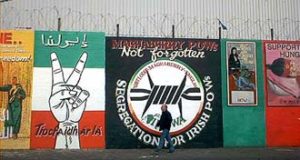
One evening as I walked with Seamus and Paul on the old walls of Derry, Seamus led us to a point that overlooked the ‘Fountain’, a walled-in district where citizens fiercely defend their loyalty to England. Over the soccer field the British Union Jack fluttered in the wind as some kids did a kick-about. “We shouldn’t stand here too long,” Seamus warned, “if they see us they will start yelling at us and calling us names.” (photo right, Palestine banner among others)
Then looking in another direction Seamus pointed out the Catholic IRA Sinn Fein-controlled district where the Irish tri-color flies. Some here also fly the Palestinian flag as protest against Britain’s occupation of Northern Ireland. Not surprisingly, some residents of the Protestant Fountain fly the flag of Israel.
Like many survivors of war, he still feels a simmering regret that “all these people,”—sweeping a hand toward the Fountain—”are my fellow Irish. We share the same culture, language, heritage—and we’ve been divided by hatred.”
Today, Seamus has for the most part been able to break free of the conditioned anger of his community. This has come about, he claims, for three reasons. The first is being able to see the prison that hatred creates in the mind. “If you can’t see beyond that, you are condemned, I think. I always felt that our common humanity was somehow bigger than the Troubles.”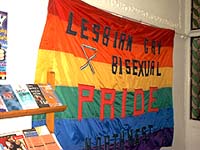
Another peace-making force in his life has been his homosexuality. “The homosexual community did not become divided between Protestant and Catholic, loyalist or republican the way many others did. There was never any trouble in our community that way. We saw each other as a group outside the conflict. We were not welcome by either side of the Troubles. It’s probably the only thing they could agree on, but it helped me to see how wrong both sides were.”
A third assist has been the presence of Paul for almost two years. They walked into each other’s lives at a club one night. Initially both felt that tug of sexual appeal but quickly found a deeper feeling. Seamus sensed that Paul’s calm demeanor had a soothing effect of him—not to mention that at the time, Seamus was unsettled with no fixed address so he literally came to Paul’s place with suitcase in hand. (They have since separated as a couple but continue to be friends.)
Paul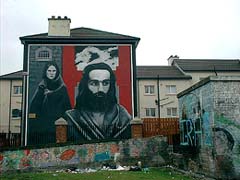
Ten years ago Paul lived in a rural town of 1500 in Galway County, Ireland swamped in a conservative Catholic family. He had scores of Catholic relatives for whom homosexuality was a distant sin somewhere beyond the bogs in the big cities. Isolated in his emerging sexual imaginings, frightened by his own impulses to admire other boys and captive to an oppressive mantel of religious morality, his emotional life was fraught with anxiety and confusion. (photo right: Derry Wall mural depicting Raymond McCartney leader of a hunger strike–later released as part of the ’Good Friday Agreement’)
“I felt devoid of an identity—not a ‘normal’ son (he has three brothers) who wondered about girls. I felt I was not a good Catholic who could be cured of sin by confession because it was not something I did but something I was. I was trapped and depressed. My most important feelings had to be kept a secret from everyone, which separated me from everyone I loved. It was so confusing and painful.”
Today his relationship with Seamus is sincere and deep. For both of these young modern Irish Catholic men, falling in love has beame a slow healing process from the ravages of war—inward and outward.
Derry Wall Mural Depicting Raymond McCartney leader of the 1st H-block hunger strike–later released as part of the’Good Friday Agreement’.
Their mutual presence help steel them against the lingering specter of sectarian hate, the insidious fear of rejection and the flow of venom from self-righteous pulpits.
For his part, Seamus helped Paul to develop a strong edge in proclaiming his viable manhood—his gay manhood. His self-confidence reached a peak recently when he agreed to write his coming out story for the local Derry newspaper, which he knew his family and many relatives would see.
In that article, he defiantly proclaimed, “One of the Church’s strong beliefs is that it is OK to be homosexual because that is the way God made you but that you daren’t practice it. That is a test of your moral will. Well, call me queer but even in writing the sheer hypocrisy shines through—not to mention the whole morality issue that everyone is born equal and made in the image and likeness of God. People often question why homosexuals turn away from the Church but if you look closely at these teachings you find that it is the Church who has turned her back on homosexuals.“
Paul’s strength is continuously tested by his father’s refusal to Paul about anything to do with his homosexuality. (Seamus’ mother went off to pray at the shrine of Fatima in Spain for his cure.) But these two men are committed to their ‘recovery’ from the toxins of their past. They live together; they share each other’s deeper thoughts and weave their feelings together into an intimate net of security in a newly emerging ‘post-war’ city (Derry) and state (Northern Ireland). Ulster has a 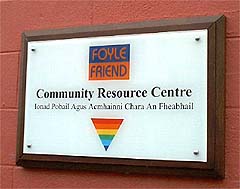 tenuous peace now and these two men have found a secret garden that they hope can nurture them—as much as love can protect anyone from the harsh barbarities of homophobia.
tenuous peace now and these two men have found a secret garden that they hope can nurture them—as much as love can protect anyone from the harsh barbarities of homophobia.
Foyle Friend–Rainbow Project
When we met, Paul and Seamus volunteered at Foyle Friend (now called Rainbow Project) where they encounter further support and friends. Foyle Friend (named after the River Foyle that flows through the city) is Derry’s (if not Northern Ireland’s) premier lesbigay community center. The day I arrived the action was bustling, varied and welcoming as Paul showed me around. It was founded in 1980 and is currently directed by Sean Morrin who sees the need to offer isolated and lonely gay youth an open arm. Today it’s a lively place with a drop in coffee house (youth, over 25’s and women each have separate times), counseling services, a web site (http://www.foylefriend.org), housing project, phone help line, support groups of all kinds including HIV, a library and internet access.
(Unfortunately, Foyle Friend closed in 2003 for lack of funding. In its place now is Rainbow Project.)
Derry Rainbow Project
After Paul showed me around Foyle Friend, he and Seamus and Michael and I went out for lunch at a local trendy café for a delicious nosh. They told me I must visit Derry’s other major gay organization, the Derry Rainbow Project whose offices were only a block away from Foyle Friend.
I could feel the energy of the Rainbow Project even before I entered their offices. Plastered around the hall and doorway were photo displays of Rainbow’s recent participation in this year’s and festival. Staff members and clients showed up in colorful outfits and outrageous costumes during the daylong celebration. They were definitely there and queer.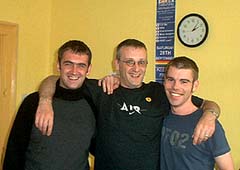
I was happily greeted by David McCartney, the Program Coordinator for RP (center in photo) who was only too pleased to give me the details for each photo. As a political statement, gay participants wore rainbow colored sashes instead of the usual orange ones of the other marchers. The reaction? “A lot of people just looked at us—probably because they didn’t get it—and some people cheered for us. There was not a single boo, which is progress here.”
The Rainbow Project, with offices in Derry and Belfast, was started in 1994 after the death of activist Jim McShane whose friends saw the stark need for an AIDS organization. They got funding from well established HIV groups in UK such as the Terrence Higgins Trust to support, advise and make medical referrals for individuals effected by STDs and HIV.
Today the caseload is about 30 clients (in Derry) with AIDS and more with HIV. David said there is only one re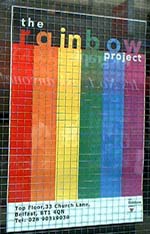 liable and knowledgeable doctor in Derry whom the Project refers to initially. Further follow-up and treatment is referred to the Belfast Royal Victoria Hospital; they have an HIV unit. But even there, he said, the services can be slow; it takes ten days to get the results for an HIV test.
liable and knowledgeable doctor in Derry whom the Project refers to initially. Further follow-up and treatment is referred to the Belfast Royal Victoria Hospital; they have an HIV unit. But even there, he said, the services can be slow; it takes ten days to get the results for an HIV test.
As we spoke, David lit up a cigarette, which evoked a wry comment from me. He said there is a high percentage of HIV people who smoke, “These cheap cigarettes in Europe are more addictive than the ones from the USA. They’re also cheaper so the rate of addiction is higher and stronger.”
Rainbow is kept busy with outreach services to organizations, companies, and universities who want informed and up-to-date information on HIV as well as prevention strategies. Last year Rainbow distributed over 52,000 condom packs, which also include health educational materials.
The most exciting news in RP’s history was the recent grant of an enormous donation of 300,00 UK pounds (about $450,000) from the Princess Diana Foundation for education and health related support services. David was very thrilled, as was the entire staff; it is t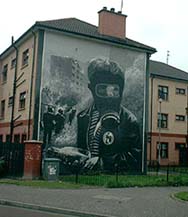 he largest award ever made by the Foundation to any group. RP intends to increase their staff and widen their scope of services throughout Northern Ireland.
he largest award ever made by the Foundation to any group. RP intends to increase their staff and widen their scope of services throughout Northern Ireland.
(photo right: wall mural depicting tear gas attack)
After David and I had talked for a while, Dennis Cassidy-Martyn, (left in photo above) a Church of Ireland minister, AIDS client and volunteer counselor dropped in. Affable and warm, he sat down as I asked what effect the Troubles had on gay people in Northern Ireland. Dennis said, “inside the gay community there was never any hostility. I know Catholic and Protestant couples. We mixed as if there were no fighting going on. Of course if you were gay you kept it a secret, and if you were a Catholic dating a Protestant guy, well, that could’ve been really dangerous in the wrong neighborhood. So you kept very quiet about that.”
Added David, “I’d say there was an effect of the Troubles on our community: drug abuse. My experience with others is that prescription drug use was much higher during that time–drugs for anxiety and depression. For those of us who could not afford to move away to the rural areas (where the hostility was much less or absent), the anxiety and apprehension were awful. People were killed at random without any notice. The possibility of being killed at any moment makes you very nervous; it kept me on alert all the time.
It must be mentioned that amid the bloody violence perpetrated by both British and IRA forces in the past, a most unexpected irony stands out: the political leadership of the IRA, the Sinn Fein party headed by Jerry Adams has always advocated gay rights, equality and protections. Despite the media’s stigmatizing Sinn Fein for its intransigent and brutal policies, this rebellious party has been the most progressive for gays of any party in Northern Ireland for many years.
















